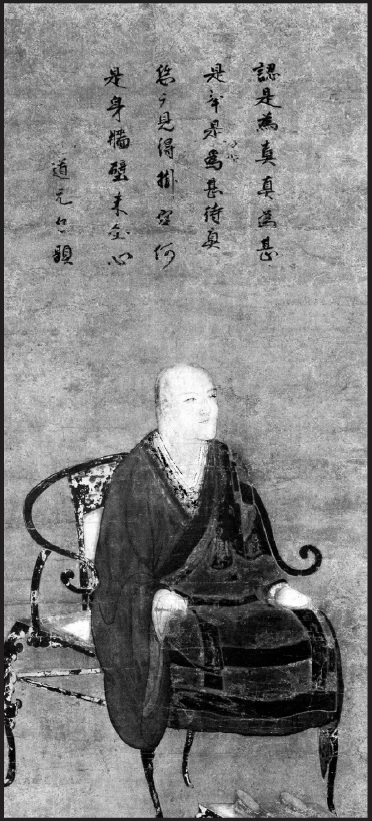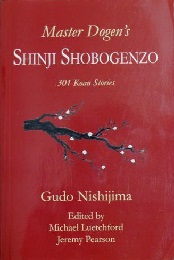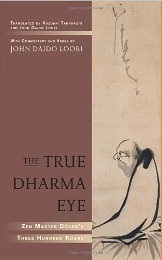ZEN IRODALOM ZEN LITERATURE
« Zen főoldal
« vissza a Terebess Online nyitólapjára


[永平] 道元希玄 [Eihei] Dōgen Kigen (1200–1253)
正法眼蔵三百則
(Rōmaji:) Shōbōgenzō sambyakusoku (also known as the 真字正法眼蔵 Mana/Shinji Shōbōgenzō)
(English:) True Dharma Eye 300 Cases (Treasury of the True Dharma Eye)
(Magyar:) Az igaz törvény szemefénye* (300 kóan) / A törvény igazlátó szeme**
*©Terebess Gábor **©Végh József
Compiled in 1235, first published in Japanese in 1766. The literary sources of the Shinji Shōbōgenzō are believed to have been the 景德伝灯錄 Jingde chuandeng lu (Keitoku Dentōroku) and the 宗門統要集 Zongmen tongyao ji (Shūmon Tōyōshū).
Tartalom |
Contents |
Végh József: PDF: Dógen Zen mester magyarul elérhető írásai Hrabovszky Dóra: Fukan-zazen-gi A zazen dicsérete Az ülő meditáció szabályai (Sóbógenzó zazengi) A zazen ösvénye A szívében a megvilágosodás szellemével élő lény (bódhiszattva) négy irányadó tevékenysége Életünk kérdése (Gendzsókóan 現成公案) PDF: Az Út Gyakorlásában Követendő pontok |
真字正法眼蔵 [Mana/Shinji] Shōbōgenzō 仮字正法眼蔵 [Kana/Kaji] Shōbōgenzō 普勧坐禅儀 Fukan zazengi 学道用心集 Gakudō-yōjinshū Advice on Studying the Way 永平清規 Eihei shingi Eihei Rules of Purity 永平廣錄 Eihei kōroku Dōgen's Extensive Record 宝慶記 Hōkyō-ki Memoirs of the Hōkyō Period 傘松道詠 Sanshō dōei Verses on the Way from Sanshō Peak
孤雲懷奘 Kōun Ejō (1198-1280) 修證義 Shushō-gi, compiled in 1890 Kōshō-ji PDF: The Life of Dōgen Zenji |
In Japan and the West, the term Shōbōgenzō is most commonly known as referring to the titles of two works composed by Japanese Zen master Dōgen Kigen in the mid-13th century.
The first written and completed in 1235, the Shinji Shōbōgenzō, also known as the Mana Shōbōgenzō or Shōbōgenzō Sanbyakusoku is a collection of 301 koans (public cases) and is written in Chinese, the language of the original texts from which the koans were taken.
In his Dogen's Manuals of Zen Meditation, Carl Bielefeldt acknowledges that Dogen likely took the title from Dahui for his first Shōbōgenzō koan collection and kept it for his following Shōbōgenzō commentary collection:
Indeed the fact that Dōgen styled his effort "Shōbō genzō" suggests that he had as his model a similar compilation of the same title by the most famous of Sung masters, Ta-Hui Tsung-kao. Unlike the latter, Dōgen was content here simply to record the stories without interjecting his own remarks. A few years later, however, he embarked on a major project to develop extended commentaries on many of these and other passages from the Ch'an literature. The fruit of this project was his masterpiece--the remarkable collection of essays known as the kana, or "vernacular", Shōbō genzō.
Dahui's Shōbōgenzō
Dahui Zonggao, the famous popularizer of koans in the Sung period of China, wrote a koan collection titled 正法眼藏 Zhengfa Yanzang (Treasury of the Correct Dharma Eye, W-G.: Cheng-fa yen-tsang, J.: Shōbōgenzō). Dahui's Shōbōgenzō is composed of three scrolls prefaced by three short introductory pieces. Upon arriving in China, Dogen Kigen first studied under Wuji Lepai, a disciple of Dahui, which is where he probably came into contact with Dahui's Shōbōgenzō.

PDF: Master Dogen's Shinji Shobogenzo, 301 koan stories
translated by Gudo Nishijima,
edited by Michael Leutchford and Jeremy Pearson
Windbell Pubns Ltd., 2003, 386 pages
PDF: Introduction to the Shinji Shobogenzo by Gudo Wafu Nishijima

PDF: The True Dharma Eye: Zen Master Dogen's Three Hundred Koans
with commentary and verse by John Daido Loori, translated by Kazuaki Tanahashi and John Daido Loori;
Boston: Shambhala Publications, 2005, 528 pages
Tanahashi, Kazuaki (1933-)
A collection of three hundred koans compiled by Eihei Dogen, the thirteenth-century founder of Soto Zen in Japan, this book presents readers with a uniquely contemporary perspective on his profound teachings and their relevance for modern Western practitioners of Zen. Following the traditional format for koan collections, John Daido Loori Roshi, an American Zen master, has added his own commentary and accompanying verse for each of Dogen's koans.
For a detailed and learned comparative discussion of the two Shobogenzo texts, together with a useful index of the appearance of the koan stories in Master Dogen's works, the reader is referred to
PDF: Dogen and the Koan Tradition – A Tale of Two Shobogenzo Texts
by Steven Heine, published by the State University of New York Press, 1994.
Koans in the Dogen Tradition: How and Why Dogen Does What He Does with Koans by Steven Heine
Philosophy East and West, Volume 54, Number 1, January 2004 pp. 1-19.
http://www.thezensite.com/ZenEssays/DogenStudies/koans_in_the_dogen_tradition.pdf
仮字正法眼蔵 [Kana/Kaji] Shōbōgenzō. 1231–1253. In DZZ, vols. 1–2.